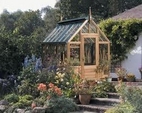Greenhouses: Getting Ready
 I was reviewing the archives, I had already written about corn. Not wanting to be redundant I just wanted to say it is too early to plant corn with the cold and wet. Now let us talk about the greenhouse as many Dear Readers have started this last year with the greenhouse advance seed starter programs This is such a lovely place to sit and read a book while the snow showers and rain beat upon the glazing.
I was reviewing the archives, I had already written about corn. Not wanting to be redundant I just wanted to say it is too early to plant corn with the cold and wet. Now let us talk about the greenhouse as many Dear Readers have started this last year with the greenhouse advance seed starter programs This is such a lovely place to sit and read a book while the snow showers and rain beat upon the glazing.
Pests, such as the dreaded nemesis of mine: Whiteflies, had caused me to lose my entire seed starter plantings last year, I had been watching their population explosion over three years and finally it was clouds of whiteflies. When all the soft delicious tomato and pepper plants shriveled up they moved on to the next plant, eventually going from delicious succulents to cabbage, their least favorite.
As my nature is one of experimenting I had first tried common over the counter consumer pest sprays. No avail, they were useless. I tried Neem oil, soaps, yellow sticky traps, and such to no avail. I decided to use 16th Century Technology. I experimented with Tansy. My homemade sprays were not successful but the direct laying of Tansy on the plants was an improvement, but not a success. I do think Tansy, with more experimenting has merit but for this year when the little beasties showed up in February it was time to seek professional help.
I still wanted to be organic and not use harsh chemical pesticides for my health and for the organic plants I was giving away.
I spent a hundred bucks and ordered from www.hpsseed.com . The product name is BotaniGard ES.
Following directions this was successful. It appears that the whiteflies lay eggs in the soil and the larvae affix them selves on the underside of the plant’s soft leaves. With billions of eggs, the plant is sucked dry-withers-and curls up. The above product I found is best sprayed on the soil and not the plant-so you need an adjustable inexpensive sprayer. Later on when the whiteflies disappeared another infestation of something appeared which looked like miniature fleas. By spraying the soil they too went to buggy Heaven. I now use the spray bottle, affixed for spraying the flats BEFORE planting the seeds and once the transplant is replanted into the growing container I spray the soil around the container.
In order to understand the process the preparation releases “spores” into the soil that attacks the hatching eggs. So far it has killed out the whiteflies and the flea beetles; the latter is of interest to me since when I plant eggplants and such soft tissue squashes in the garden soil outside I might have improved successes. Usually I have had to serialize the soil with a flamethrower LP weed burner, place the eggplant in the soil, water carefully and then place a handmade-screened cover box contraption over the area that would be the plants growth. Maybe this year I will win.
This year I have a bountiful greenhouse starter crop and highly recommend BotaniGard ES. Being this is a living product of spores I keep it in my refrigerator in the Herb House. Since I am not commercial this product may last me for years.
The question arises: “Where did the bugs come from?” I broke the cardinal rule that absolutely NO plants are brought into the greenhouse from some store displays. Just one tiny egg and you have had it.
I have lately been purchasing Miracle Grow potting soil and noticed mushrooms popping up in the growing beds. I think they are interesting, however I suspect that the mushroom growers who are constantly replacing their growing medium are recycling it, and with the addition of forest ground up trees bark this too may be a source of pests. I have returned to my pH-adjusted use of Sphagnum Moss and make my own potting soil and starter soils. You may find this formula in the beginning archives.
This Sunday, May 15th, I will have finished my deer proofing fence: a combination of Farm-Tech.com Dura- mesh coated chicken wire, concreted 4x4x10’ posts and two electric fence charged barbed wire strands. More on this later. A neighbor tilled his garden, placed fiberglass poles 6’ high and attached six strands of electric fenced charged tape (wire) around the area. This looks good and will comment on its success later on when I can take some photos. You will most likely need deer proofing for your plants, as they are getting pesky, intruding right into the suburb gardens.
I also purchased 4-mole solar powered ground throbbing irritating noise makers (to underground burros) from Harbor Freight.com and am attempting to drive away the groundhogs, or at least train them to stay away. I could shoot them, perhaps 25 or more easily on warm day, but I believe they are, from an eco system view, beneficial in making tunnels and burrows for the rabbits and others who need such shelters who pile up poop for the trees and of course water course channels underground. However, I am cognizant of how tasty the young groundhog is, and I have lots of recipes when they may be invited to my dinner table when times get tough. In the mean time the pulsing underground noisemakers may do the job and everyone will remain happy in their own boundaries.
Wild rabbits will depreciate the garden and the best solution is an 18” or higher plastic boundary fence. This bottom physical barrier, in my opinion is better than an electric fence wire since weeds grow so fast along the fence line they short out the electric charge. I place my electric fence wire up 4’ above ground to spark the raccoons that will be after my corn.
I digress a bit so let me get back to the greenhouse discussion. My Growhaus #2, the 10’x20’ model stood well the rigors of ice and snow the past two years and I hope to make a few improvements, especially now to disregard the clear plastic film coverage and upgrade to fiberglass corrugated coverings. Fiberglass in my opinion is the better of window glazing for greenhouses. I am especially intrigued with the idea of making the entrance and exit as a wheelchair ramp for elderly and those who still want to putter in a greenhouse environment. This concept might be considered for nursing and eldercare homes instead of vegetating in front of a TV, or stupefied on tranquillizers.
Discussions with my publisher indicates that I may make some video clips next year on the subject of plant starting, and on into the garden. If so, this will give newbies lots of help since a picture is worthy a thousand words, but with video maybe tens of thousands, of words. -New ideas and motivations, which is the purpose of this B2L series. Of course in the mean time I have to study up on the intricacies of modern technology.
God Bless,
Old Timer
COPYRIGHT: 2011, Back2theLand.com, Mark Steel- all rights reserved.



